Characteristics and Geological Significance of CO2-Rich Fluid Inclusions in Dakalasu No. 1 Pegmatite Dyke, Altay
Abstract
1. Introduction
2. Geological Background

3. Sampling and Methodology
3.1. Microthermometry
3.2. Raman Spectroscopy
3.3. LA-ICP-MS Microanalysis
4. Results
4.1. Fluid Inclusion Petrography
4.2. Microthermometry
4.3. Raman Spectroscopy
4.4. LA-ICP-MS
5. Discussion
5.1. Nature and Evolution of the Ore-Forming Fluids
5.2. The Role of CO2-Rich Fluids in Rare Metal Enrichment and Mineralization
6. Conclusions
Author Contributions
Funding
Institutional Review Board Statement
Informed Consent Statement
Data Availability Statement
Acknowledgments
Conflicts of Interest
References
- Mao, J.W.; Yuan, S.D.; Xie, G.Q.; Song, S.W.; Zhou, Q.; Gao, Y.B.; Liu, X.; Fu, X.F.; Cao, J.; Zeng, Z.L.; et al. New advances on metallogenic studies and exploration on critical minerals of China in 21st century. Miner. Depos. 2019, 38, 935–969. (In Chinese) [Google Scholar] [CrossRef]
- Wang, D.H. Discussion on issues related to strategic key mineral resources. Geol. Chem. Miner. 2019, 41, 65–72. (In Chinese) [Google Scholar]
- Zhang, H.; Lv, Z.H.; Tang, Y. Metallogeny and prospecting model as well as prospecting direction of pegmatite-type rare metal ore deposits in Altay orogenic belt, xinjiang. Miner. Depos. 2019, 38, 792–814. (In Chinese) [Google Scholar] [CrossRef]
- Li, W.C.; Li, J.W.; Xie, G.Q.; Zhang, X.F.; Liu, H. Critical minerals in China: Current status, research focus and resource strategic analysis. Earth Sci. Front. 2022, 29, 1–13. (In Chinese) [Google Scholar] [CrossRef]
- Liu, L.J.; Fu, X.F.; Wang, D.H.; Hao, X.F.; Yuan, L.P.; Pan, M. Geological characteristics and metallogeny of Jiajika-style rare metal deposits. Miner. Depos. 2015, 34, 1187–1198. (In Chinese) [Google Scholar] [CrossRef]
- Wang, D.H.; Liu, L.J.; Hou, J.L.; Dai, H.Z.; Yu, Y.; Dai, J.J.; Tian, S.H. A preliminary review of the application of “Five levels+Basement” model for Jiajika-style rare metal deposits. Earth Sci. Front. 2017, 24, 1–7. (In Chinese) [Google Scholar] [CrossRef]
- Soliman, A.A.; Anthony, E.W.J. The rare metal deposits of the El Garra El Hamra syenites, South Western Desert, Egypt. Ore Geol. Rev. 2018, 101, 609–628. [Google Scholar] [CrossRef]
- Yue, X.Y.; Zhang, Y.; Zhou, X.; Gong, D.X.; Tan, H.Q.; Zhou, Y.; Zhu, Z.M. Metallogenic regularity and prospecting direction of rare metal deposits in Keeryin ore concentration area, western Sichuan. Miner. Depos. 2019, 38, 867–876. (In Chinese) [Google Scholar] [CrossRef]
- Christophe, B.; Marlina, A.E.; Sebastian, T.; Christian, R.; Henriette, U.; Shane, D. Magmatic-hydrothermal evolution of rare metal pegmatites from the Mesoproterozoic Orange River pegmatite belt (Namaqualand, South Africa). Ore Geol. Rev. 2020, 116, 103252. [Google Scholar] [CrossRef]
- Shen, P.; Pan, H.D.; Li, C.H.; Feng, H.X.; Luo, Y.Q.; Ma, M.D.; Suo, Q.Y.O.; Bai, Y.X.; Wu, Y. Temporal-spatial Distribution, Genesis and Metallogenic Regularity of the Rare Metal Deposits in Altay of China, Kazakhstan and Russia. J. Earth Sci. Environ. 2021, 43, 487–505. (In Chinese) [Google Scholar] [CrossRef]
- Yu, Y.; Li, Z.F.; Bai, L.A.; Xu, H.; Zhang, Q.N.; Liang, J. Metallogenic regularity and prospecting direction of pegmatitic rare-mental deposits in western Yunnan. Acta Petrol. Sin. 2022, 38, 2052–2066. (In Chinese) [Google Scholar] [CrossRef]
- Kogarko, L.N. Peculiarities of the Formation of Loparite Ores: The Lovozero Rare Metal Deposit, East Fennoscandia. Dokl. Earth Sci. 2022, 505, 2. [Google Scholar] [CrossRef]
- Abramova, V.A. Rare Alkali Metals in the Waters of Lithium-containing Deposits in Eastern Transbaikalia. IOP Conf. Ser. Earth Environ. Sci. 2022, 962, 012001. [Google Scholar] [CrossRef]
- Zou, T.R.; Zhang, X.C.; Jia, F.Y.; Wang, R.C.; Cao, H.Z.; Wu, B.Q. The origin of No. 3 pegmatite in Altay shan, Xinjiang. Miner. Depos. 1986, 4, 34–48. (In Chinese) [Google Scholar] [CrossRef]
- Zou, T.R.; Cao, H.Z.; Wu, B.Q. Orogenic and anorogenic granitoids of the Alty Mountains, Xinjiang and their discrimination criteria. Acta Geol. Sin. 1988, 3, 228–245. (In Chinese) [Google Scholar] [CrossRef]
- Zhu, Y.F.; Zeng, Y.; Gu, L. Geochemistry of the rare metal-bearing pegmatite No. 3 vein and related granites in the Keketuohai region, Altay Mountains, northwest China. J. Asian Earth Sci. 2006, 27, 61–77. (In Chinese) [Google Scholar] [CrossRef]
- Ren, B.Q.; Zhang, H.; Tang, Y.; Lv, Z.H. LA-ICPMS U-Pb Zircon Geochronology of the Altai Pegmatites and Its Geological Significance. Acta Mineral. Sin. 2011, 31, 587–596. (In Chinese) [Google Scholar] [CrossRef]
- Lv, Z.H.; Zhang, H.; Tang, Y.; Guan, S.J. Petrogenesis and magmatic-hydrothermal evolution time limitation of Kelumute No. 112 pegmatite in Altay, Northwestern China: Evidence from zircon U-Pb and Hf isotopes. Lithos 2012, 154, 374–391. [Google Scholar] [CrossRef]
- Feng, L.; Xin, Z.Z.; Qi, L.; Chao, Z.; Chao, L. New precise timing constraint for the Keketuohai No. 3 pegmatite in Xinjiang, China, and identification of its parental pluton. Ore Geol. Rev. 2014, 56, 209–219. [Google Scholar] [CrossRef]
- Lv, Z.H.; Zhang, H.; Tang, Y. Study on the genetic relationship between the Li-Nb-Ta deposit and the surrounding rock granite of the No.L1 pegmatite vein in Bi, Xinjiang. Acta Mineral. Sin. 2015, 35, 323. (In Chinese) [Google Scholar] [CrossRef]
- Ma, Z.L.; Zhang, H.; Tang, Y.; Lv, Z.H.; Zhang, X.; Zhao, J.Y. Zircon U-Pb geochronology and Hf isotopes of pegmatites from the Kaluan mining area in the Altay, Xinjiang and their genetic relationship with the Halong granite. Geochimica 2015, 44, 9–26. (In Chinese) [Google Scholar] [CrossRef]
- Zhang, X.; Zhang, H.; Ma, Z.L.; Tang, Y.; Lv, Z.H.; Zhao, J.Y.; Liu, Y.L. A new model for the granite-pegmatite genetic relationships in the Kaluan-Azubai-Qiongkuer pegmatite-related ore fields, the Chinese Altay. J. Asian Earth Sci. 2016, 124, 139–155. [Google Scholar] [CrossRef]
- Lv, Z.H.; Zhang, H.; Tang, Y. Anatexis origin of rare metal/earth pegmatites: Evidences from the Permian pegmatites in the Chinese Altai. Lithos 2020, 380–381, 105865. [Google Scholar] [CrossRef]
- Wu, C.N.; Zhu, J.C.; Liu, C.S.; Xiong, X.L. Study of compositions of melting fluid inclusions in pegmatites, Altay, Xinjiang. Geochimica 1995, 24, 351–358. (In Chinese) [Google Scholar] [CrossRef]
- Wang, D.H.; Chen, Y.C.; Li, H.Y.; Xu, Z.G.; Li, T.D. Research Progress of Metallogenic Regularity Series in Altay Orogenic Belt, Xinjiang. Geol. Rev. 1998, 1, 62. (In Chinese) [Google Scholar] [CrossRef]
- Li, Z.L.; Zhang, W.L.; Yang, R.Y.; Li, W.; Zhai, W. Electron Probe Microanalysis of Melt Inclusions in Pegmatite and Discovery of Zinc Spinel. Chin. Sci. Bull. 1999, 6, 649–652. (In Chinese) [Google Scholar] [CrossRef]
- Liu, H. Geochemical Study on Petrogenesis of Aral Granite and the Keketuohai No. 3 Pegmatite Vein, Altay Xinjiang. Ph.D. Thesis, The Kunming University of Science and Technology, Kunming, China, 2013. (In Chinese). [Google Scholar]
- Zhang, H.; Liu, C.Q. Tetrad effect of REE in apatites from pegmatite No. 3, Altay, Xinjiang and its implications. Geochimica 2001, 4, 323–334. (In Chinese) [Google Scholar] [CrossRef]
- Zhou, Q.F.; Qin, K.Z.; Tang, D.M.; Ding, J.G.; Guo, Z.L. Mineralogy and significance of micas and feldspars from the Koktokay No. 3 pegmatitic rare-element deposit, Altai. Acta Petrol. Sin. 2013, 29, 3004–3022. (In Chinese) [Google Scholar] [CrossRef]
- Qin, K.Z.; Zhai, M.G.; Li, G.M.; Zhao, J.X.; Zeng, Q.D.; Gao, J.; Xiao, W.J.; Li, J.L.; Sun, S. Links of collage orogenesis of multiblocks and crust evolution to characteristic metallogeneses in China. Acta Petrol. Sin. 2017, 33, 305–325. (In Chinese) [Google Scholar]
- Luo, W.; Peng, J.; Jin, T.F.; Yang, B.; Pang, L.W.; Zhou, Z.M. Petrogenesis and Geological Significance of the Simancuo Biotite Monzogranite in the Kereryin Area, Western Sichuan, China. Bull. Mineral. Petrol. Geochem. 2022, 41, 527–539. (In Chinese) [Google Scholar] [CrossRef]
- Cen, J.B.; Feng, Y.G.; Liang, T.; Gao, J.G.; He, L.; Zhou, Y. Implications of muscovite composition on the genesis of Lirich and Be-rich pegmatites: A case study of the Kalu’an rare-metal pegmatite ore-field. Acta Petrol. Sin. 2022, 38, 411–427. (In Chinese) [Google Scholar]
- Wang, H.; Gao, H.; Wang, S.M.; Yan, Q.H.; Wang, Z.H.; Huang, L.; Qin, Y. Zircon and columbite-tantalite U-Pb geochronology of Li-Be rare metal pegmatite and its geological significance in Muji area, West Kunlun, China. Acta Petrol. Sin. 2022, 38, 1937–1951. (In Chinese) [Google Scholar] [CrossRef]
- Guo, L.; Zhang, H.; Lv, Z.H.; Tang, Y.; An, Y.; Chen, J.Z. Hydrothermal mineralization in Triassic Li-mineralized pegmatites in the Altay area of Xinjiang: Evidences from the in situ LA-ICP-MS analyses of individual fluid inclusions. Acta Mineral. Sin. 2023, 43, 25–37. (In Chinese) [Google Scholar] [CrossRef]
- Zou, T.R. Rare and Rare Earth Metal Deposits in Xinjiang, China; Geology Press: Beijing, China, 2006. (In Chinese) [Google Scholar]
- Wang, D.H.; Chen, Y.C.; Xu, Z.G. 40Ar/39Ar Isotope Dating on Muscovites from Indosinian Raremetal Deposits in Central Altay‚ Northwestern China. Bull. Mineral. Petrol. Geochem. 2003, 22, 14–17. (In Chinese) [Google Scholar]
- Li, Q.; Yang, F.Q.; Yang, C.D. Geochronology and Geochemical Characteristics of Dakalasu Granite in Altay of Xinjiang, China and Their Tectonic Significance. J. Earth Sci. Environ. 2019, 41, 396–413. (In Chinese) [Google Scholar]
- Suo, Q.; Shen, P.; Luo, Y.Q.; Li, C.H.; Feng, H.X.; Cao, C.; Pan, H.D.; Bai, Y.X. Beryl Mineralogy and Fluid Inclusion Constraints on the Be Enrichment in the Dakalasu No. 1 Pegmatite, Altai, NW China. Minerals 2022, 12, 450. [Google Scholar] [CrossRef]
- Gunther, D. Quantitative analysis of major, minor and trace elements in fluid inclusions using laser ablation inductively coupled plasma mass spectrometry. J. Anal. At. Spectrom. 1998, 13, 4. [Google Scholar] [CrossRef]
- Hu, S.H.; Hu, Z.C.; Liu, Y.S.; Lu, Y.; Lin, S.L.; Gao, S. New techniques of major and minor elemental analysis in individual fluid inclusion-Laser Ablation Inductively Coupled Plasma Mass Spectrometry (LA-ICP-MS). Earth Sci. Front. 2001, 4, 434–440. [Google Scholar] [CrossRef]
- Li, X.C.; Fan, H.R.; Hu, F.F.; Yang, K.F. An analysis of the individual fluid inclusion by LA-ICP-MS and its application to ore deposits. Miner. Depos. 2010, 29, 1017–1028. [Google Scholar] [CrossRef]
- Yu, Q. Study on the Analysis Method of LA-ICP-MS for the Individual Fluid Inclusions Hosted in Halite. Ph.D. Thesis, China University of Geosciences, Beijing, China, 2015. (In Chinese). [Google Scholar]
- Lan, T.G.; Hu, R.Z.; Fan, H.R.; Bi, X.W.; Tang, Y.W.; Zhou, L.; Mao, W.; Chen, Y.H. In-situ analysis of major and trace elements in fluid inclusion and quartz: LA-ICP-MS method and applications to ore deposits. Acta Petrol. Sin. 2017, 33, 3239–3262. (In Chinese) [Google Scholar]
- Guo, W.; Lin, X.; Hu, S.H. Advances in LA-ICP-MS Analysis for Individual Fluid Inclusions and Applications. Earth Sci. 2020, 45, 1362–1374. [Google Scholar]
- Ni, P.; Fan, H.R.; Pan, J.Y.; Chi, Z.; Cui, J.M. Progress and Prospect of Fluid Inclusion Research in the Past Decade in China (2011–2022). Bull. Mineral. Petrol. Geochem. 2021, 40, 802–818. (In Chinese) [Google Scholar] [CrossRef]
- Liu, D.Q.; Tang, Y.L.; Zhou, R.H. Evolution of Paleozoic crust and metallogenic series in Northern xinjiang. Miner. Depos. 1992, 11, 307–314. (In Chinese) [Google Scholar]
- Xiao, C.X. Tectonic Evolution of the Northern Xinjiang and Its Adjacent Regions; Geology Press: Beijing, China, 1992. (In Chinese) [Google Scholar]
- Şengör, A.M.C.; Natal’in, B.A.; Burtman, V.S. Evolution of the Altaid tectonic collage and Palaeozoic crustal growth in Eurasia. Nature 1993, 364, 299–307. [Google Scholar] [CrossRef]
- Xiao, W.J. Palaeozoic accretionary and convergent tectonics of the southern Altaids: Implications for the growth of Central Asia. J. Geol. Soc. 2004, 161, 339–342. [Google Scholar] [CrossRef]
- Liu, F.; Yang, F.Q.; Mao, J.W.; Chai, F.M.; Geng, X.X. Study on chronology and geochemistry for Abagong granite in Altay orogeny. Acta Petrol. Sin. 2009, 25, 1416–1425. (In Chinese) [Google Scholar]
- Windley, B.F.; Kröner, A.; Guo, J.H.; Qu, G.S.; Li, Y.Y.; Zhang, C. Neoproterozoic to Paleozoic Geology of the Altai Orogen, NW China: New Zircon Age Data and Tectonic Evolution. J. Geol. 2002, 110, 719–737. [Google Scholar] [CrossRef]
- Qin, K.Z.; Xiao, W.J.; Zhang, L.C.; Xu, X.W.; Tosdal, R.M. Eight Stages of Major Ore Deposits in Northern Xinjiang, NW-China: Clues and Constraints on the Tectonic Evolution and Continental Growth of Central Asia; Springer: Berlin/Heidelberg, Germany, 2005; pp. 1327–1330. [Google Scholar]
- Han, B.F. A preliminary comparison of Mesozoic granitoids and rare metal deposits in Chinese and Russian Altai Mountains. Acta Petrol. Sin. 2008, 24, 655–660. (In Chinese) [Google Scholar]
- Yuan, C.; Sun, M.; Xiao, W.J.; Li, X.; Lin, S.; Xia, X.; Long, X. Accretionary orogenesis of the Chinese Altai: Insights from Paleozoic granitoids. Chem. Geol. 2007, 242, 22–39. [Google Scholar] [CrossRef]
- Sun, M.; Yuan, C.; Xiao, W.J.; Long, X.; Xia, X.; Zhao, G.; Lin, S.; Wu, F.; Kroner, A. Zircon U-Pb and Hf isotopic study of gneissic rocks from the Chinese Altai: Progressive accretionary history in the early to middle Palaeozoic. Chem. Geol. 2008, 247, 352–383. [Google Scholar] [CrossRef]
- Feng, Y.G.; Liang, T.; Lei, R.X.; Ju, M.H.; Zhang, Z.L.; Gao, J.G.; Zhou, Y.; Wu, C.Z. Relationship Between Undercooling and Emplacement of Rare-element Pegmatites-Thinking Based on Field Observations and Pegmatite Geochronology. J. Earth Sci. Environ. 2021, 43, 100–116. (In Chinese) [Google Scholar] [CrossRef]
- Chen, J.Z.; Zhang, H.; Tang, Y.; Lv, Z.H.; An, Y.; Wang, M.T.; Liu, K.; Xu, Y.S. Lithium mineralization during evolution of a magmatic-hydrothermal system: Mineralogical evidence from Li-mineralized pegmatites in Altai, NW China. Ore Geol. Rev. 2022, 149, 105058. [Google Scholar] [CrossRef]
- Wang, T.; Tong, Y.; Jahn, B.M. SHRIMP U-Pb Zircon geochronology of the Altai No. 3 Pegmatite, NW China, and its implications for the origin and tectonic setting of the pegmatite. Ore Geol. Rev. 2007, 32, 325–336. [Google Scholar] [CrossRef]
- Bodnar, R.J. Revised equation and table for determining the freezing point depression of H2O-NaCl solutions. Geochim. Cosmochim. Acta 1993, 57, 683–684. [Google Scholar] [CrossRef]
- Diamond, L.W. Stability of CO2 clathrate hydrate+CO2 liquid+CO2 vapour+aqueous KCl-NaCl solutions: Experimental determination and application to salinity estimates of fluid inclusions. Geochim. Cosmochim. Acta 1992, 56, 273–280. [Google Scholar] [CrossRef]
- Liu, Q.F.; Sun, X.M.; Li, D.F.; Fu, Y.; Zhai, W.; Wei, H.X.; Han, M.X.; Yi, J.Z.; Zhang, X.G. The identification of the Guqiong orogenic Ag-Au polymetallic deposit in southern Tibet: Evidences from mineralogy, geochronology and fluid evolution. Ore Geol. Rev. 2019, 111, 102950. [Google Scholar] [CrossRef]
- Heinrich, C.A.; Pettke, T.; Halter, W.E.; Aigner-Torres, M.; Aud´etat, A.; Günther, D.; Hattendorf, B.; Bleiner, D.; Guillong, M.; Hron, I. Quantitative multi-element analysis of minerals, fluid and melt inclusions by laser-ablation inductively-coupledplasma mass-spectrometry. Geochim. Cosmochim. Acta 2003, 67, 3473–3497. [Google Scholar] [CrossRef]
- Allan, M.M.; Yardley, B.W.; Forbes, L.J.; Shmulovich, K.I.; Banks, D.A.; Shepherd, T.J. Validation of LA-ICP-MS fluid inclusion analysis with synthetic fluid inclusions. Am Miner. 2005, 90, 1767–1775. [Google Scholar] [CrossRef]
- Guillong, M.; Meier, D.L.; Allan, M.M.; Heinrich, C.A.; Yardley, B.W.D. SILLS: A Matlab-based program for the data reduction of laser ablation ICP-MS data of homogeneous materials and inclusions. Mineral. Assoc. Can. 2008, 40, 328–333. [Google Scholar]
- Pan, J.Y.; Ni, P.; Wang, R.C. Comparison of fluid processes in coexisting wolframite and quartz from a giant vein-type tungsten deposit, South China: Insights from detailed petrography and LA-ICP-MS analysis of fluid inclusions. Am. Mineral. 2019, 104, 1092–1116. [Google Scholar] [CrossRef]
- Lu, H.Z. Fluid Inclusion; Science Press: Beijing, China, 2004. (In Chinese) [Google Scholar]
- Shepherd, T.J.; Rankin, A.H.; Alderton, D. A practical guide to fluid inclusion studies. Blackie 1985, 3, 35–62. [Google Scholar]
- Liu, B.; Duan, G.X. The density and isochoric formulae for NaCl-H2O fluid inclusions and their applications. Acta Mineral. Sin. 1987, 4, 345–352. [Google Scholar] [CrossRef]
- Chen, H.; Li, A.B.; Zhao, P.; Xia, X.S.; Li, R.Z.; Zhu, M.M.; Xu, H.J. Crystal Chemistry and fluid inclusions of beryl from the Mufushan Area. South China Geol. 2022, 38, 459–471. (In Chinese) [Google Scholar]
- Lu, H.Z.; Wang, Z.G.; Li, Y.S. Magma/fluid transition and genesis of pegmatite dike No. 3 at Altay, Xinjiang. Acta Mineral. Sin. 1996, 1, 1–7. [Google Scholar] [CrossRef]
- Wang, G.G.; Ni, P.; Pan, J.Y. Fluid Characteristics of Granite-Related Ore Forming Systems. Bull. Mineral. Petrol. Geochem. 2020, 39, 463–471. (In Chinese) [Google Scholar] [CrossRef]
- Deng, J.Y.; Li, J.K.; Zhang, D.H.; Chou, I.M.; Yan, Q.G. Origin of pegmatitic melts from granitic magmas in the formation of the Jiajika lithium deposit in eastern Tibetan Plateau. J. Asian Earth Sci. 2022, 229, 105147. [Google Scholar] [CrossRef]
- Wang, Y.R.; Gu, F.Y.; Zi, Q. An experimental study ofdistribution coefficients and hydrolysis of Nb and Ta and itsminerogenetic significance. Geochimica 1992, 21, 55–62. (In Chinese) [Google Scholar] [CrossRef]
- Zhao, J.S.; Zhao, B.; Rao, B. A preliminary experimental study on mineralization of Nb, Ta and W. Geochimica 1996, 25, 286–295. (In Chinese) [Google Scholar]
- Thomas, R.; Forster, H.; Rickers, K.; Webster, J.D. For mation of extremely Frich hydrous melt fractions and hydrot her mal fluid during differentiation of highly evolved tingranite magmas: A melt/fluid inclusion study. Contrib Miner. Pet. 2005, 148, 582–601. [Google Scholar] [CrossRef]
- Zhang, D.H. Some problems on the geochemistry of ore-forming processes. Geol. Bull. China 2005, 24, 885–891. (In Chinese) [Google Scholar]
- Schmidt, C.; Bodnar, R.J. Synthetic fluid inclusions: XVI. PVTX properties in the system H2O-NaCl-CO2 at elevated temperatures, pressures, and salinites. Geochim. Cosmochim. Acta 2000, 64, 3853–3869. [Google Scholar] [CrossRef]
- Lowenstern, J.B. Carbon dioxide in magmas and implications for hydrothermal system. Miner. Depos. 2001, 36, 490–502. [Google Scholar] [CrossRef]
- Lu, H.Z. Role of CO2 fluid in the formation of gold deposits: Fluid inclusion evidences. Geochimica 2008, 4, 321–328. [Google Scholar] [CrossRef]
- Zhang, D.H.; Zhang, W.H.; Xu, G.J. The ore fluid geochemistry of F-rich silicate melt-hydrous fluid system and its metallogeny-the current status and problems. Earth Sci. Front. 2004, 11, 479–490. (In Chinese) [Google Scholar]
- Seward, T.M. Thio complexes of gold and the transport of gold in hydrothermal ore solutions. Geochim. Cosmochim. Acta 1973, 37, 379–399. [Google Scholar] [CrossRef]
- Seward, T.M.; Barnes, H.L. Metal transport by hydrothermalore fluids. Geochem. Hydrothermal Ore Depos. 1997, 3, 435–486. [Google Scholar]
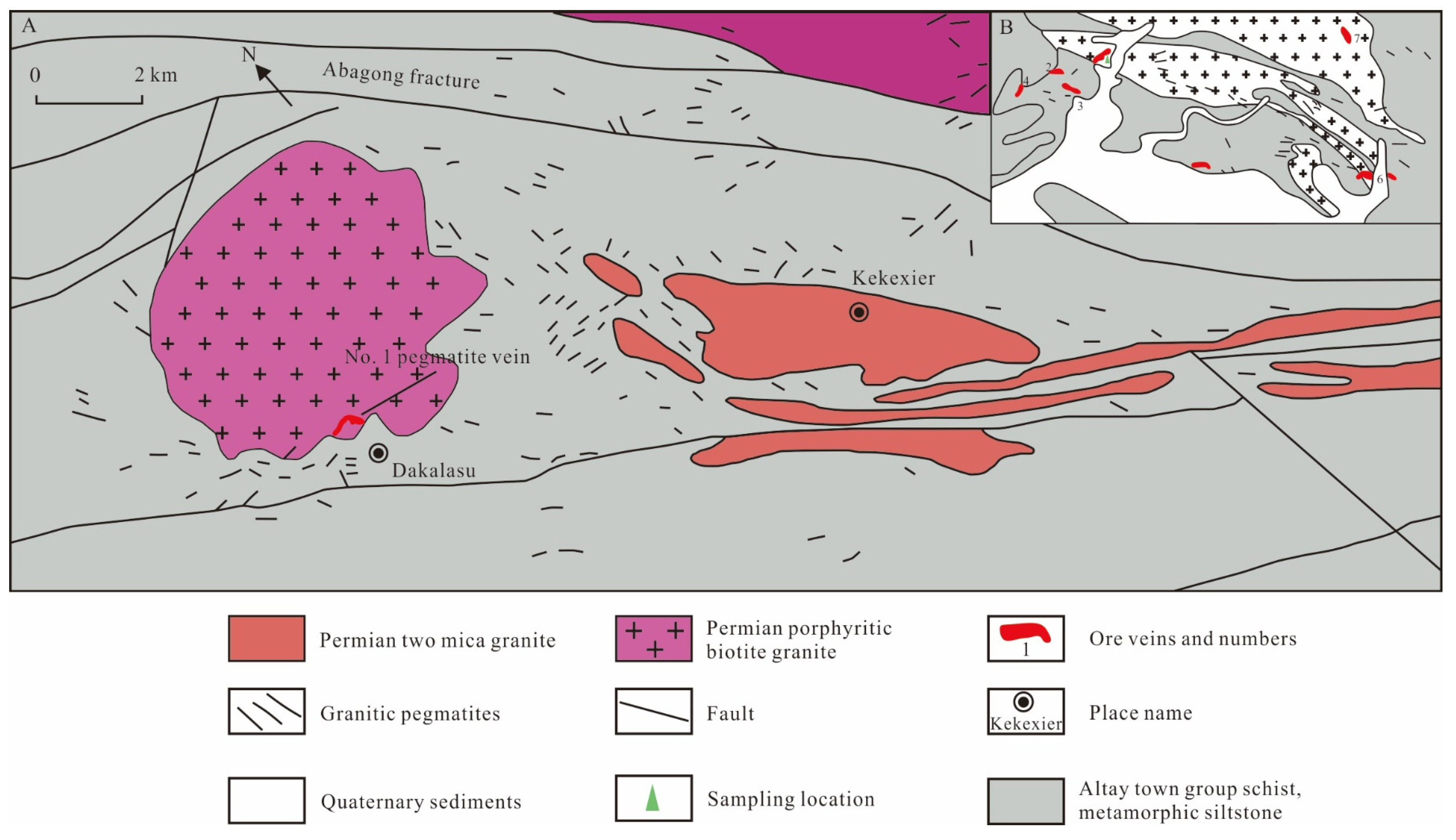
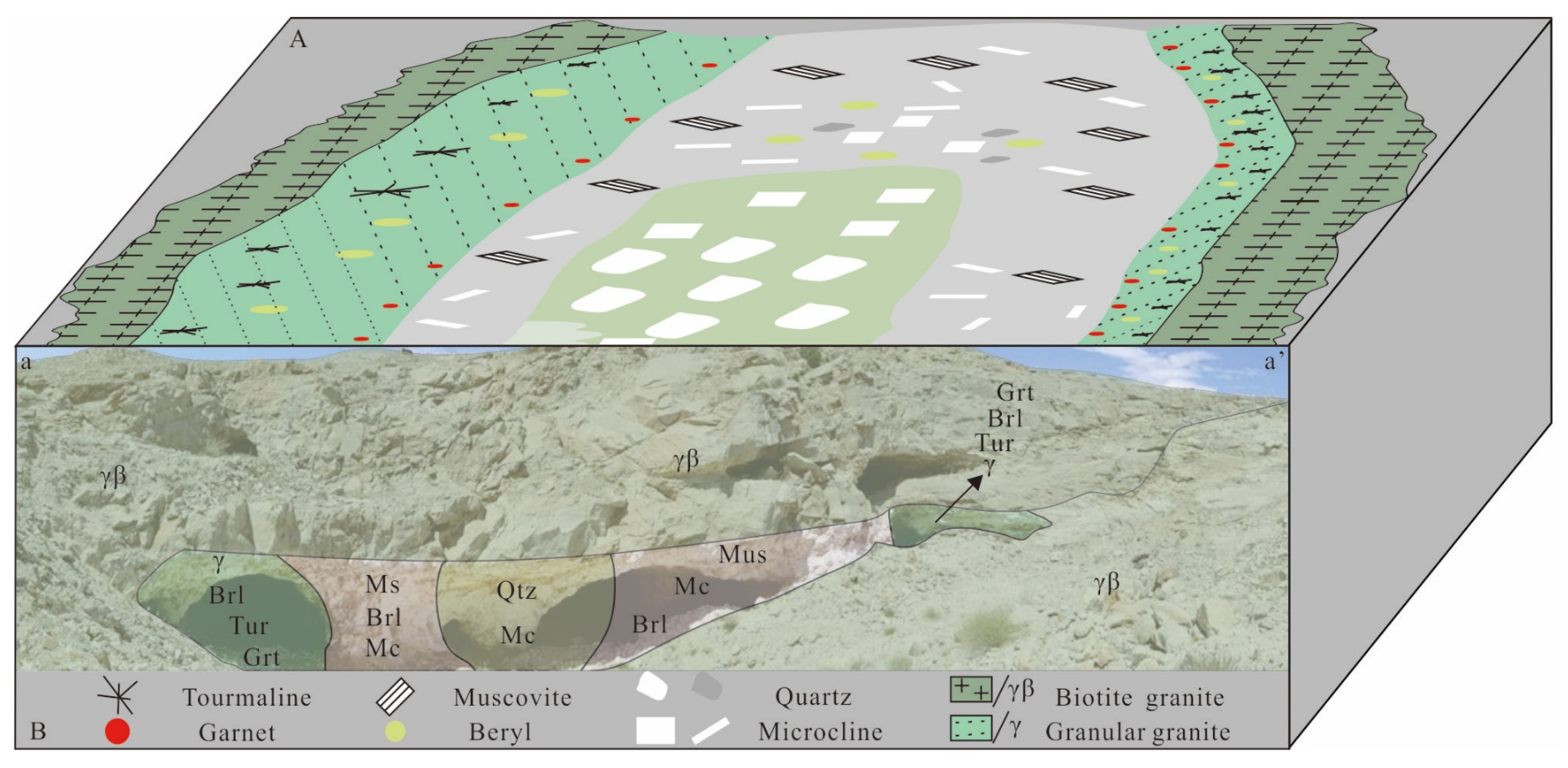

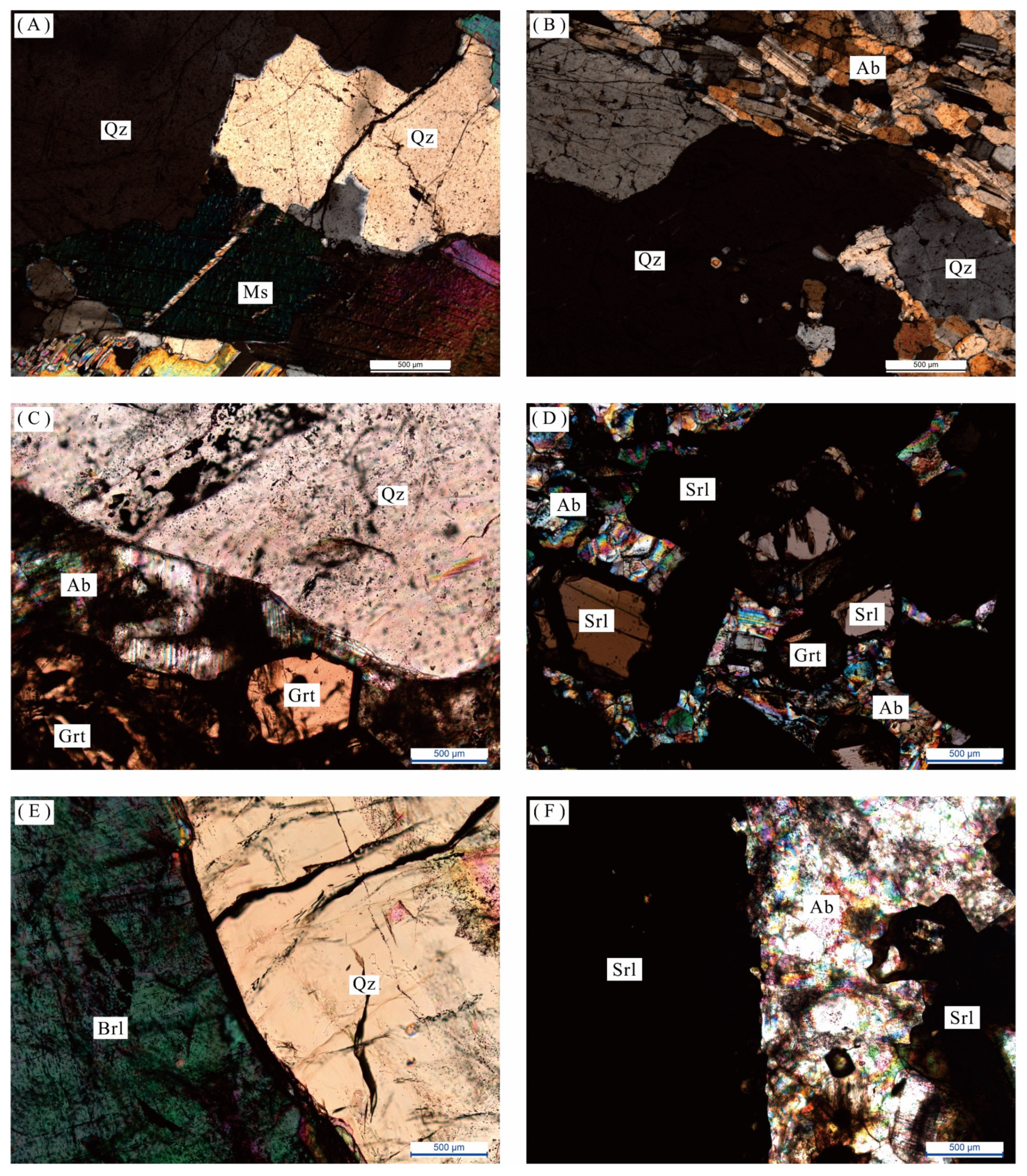
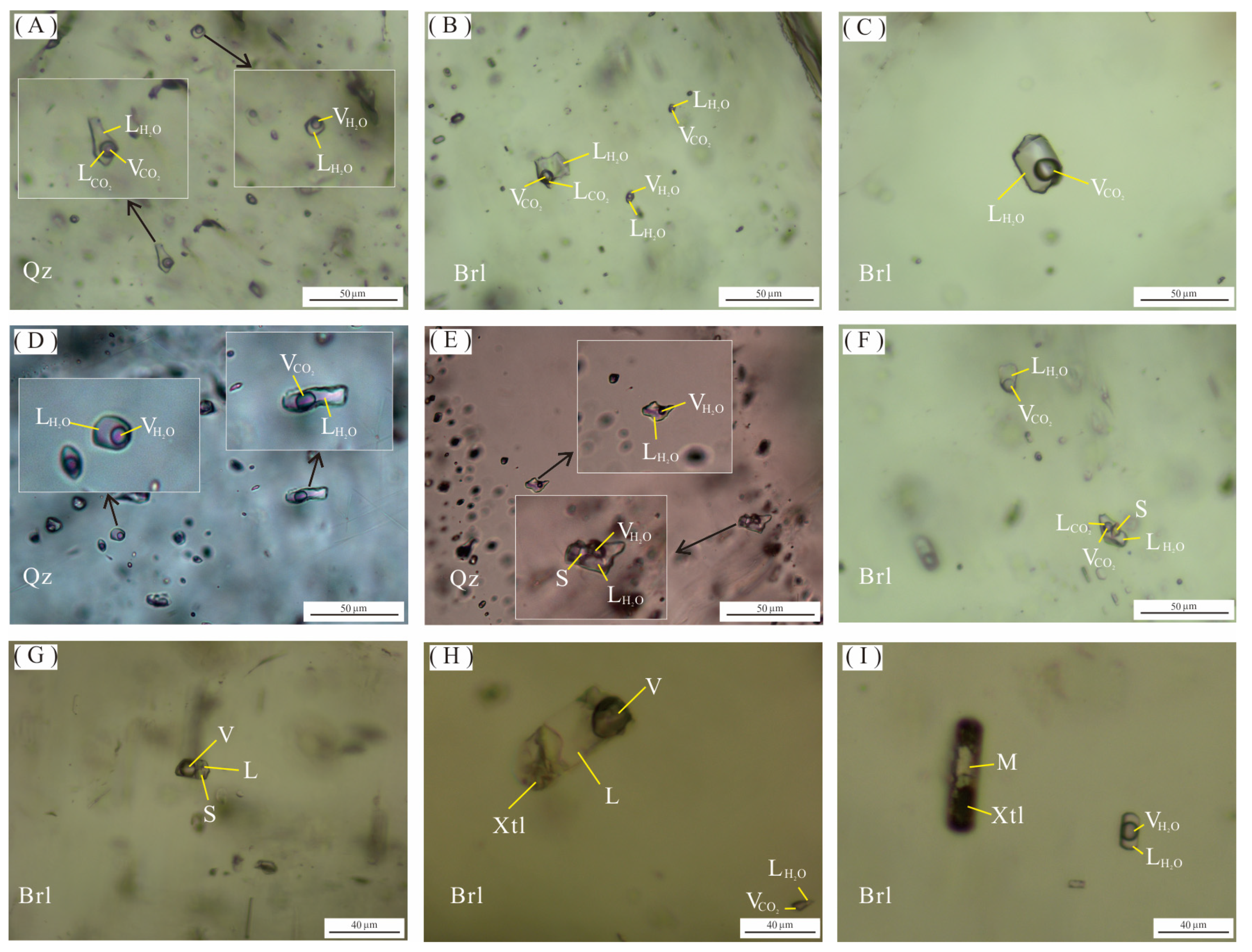
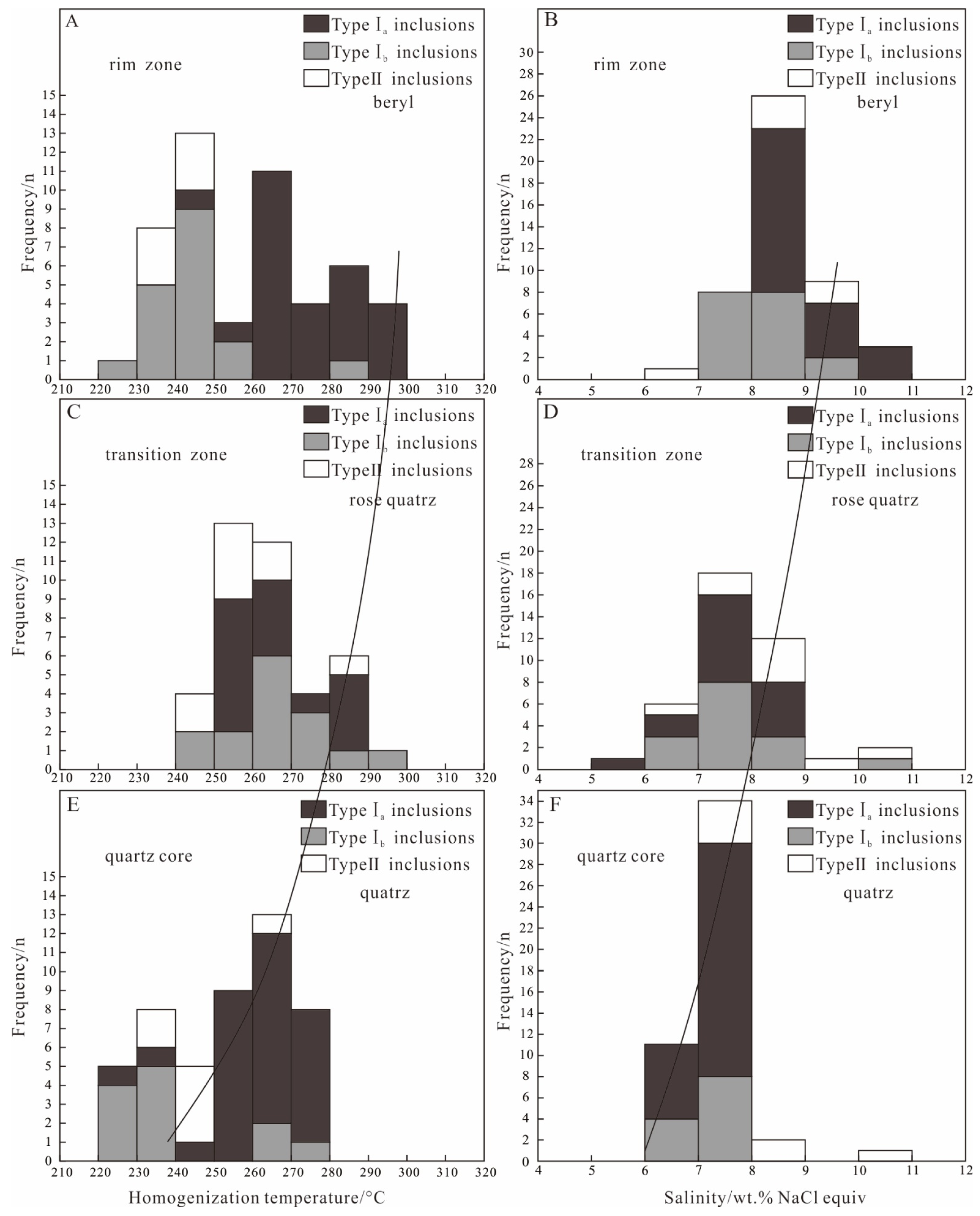
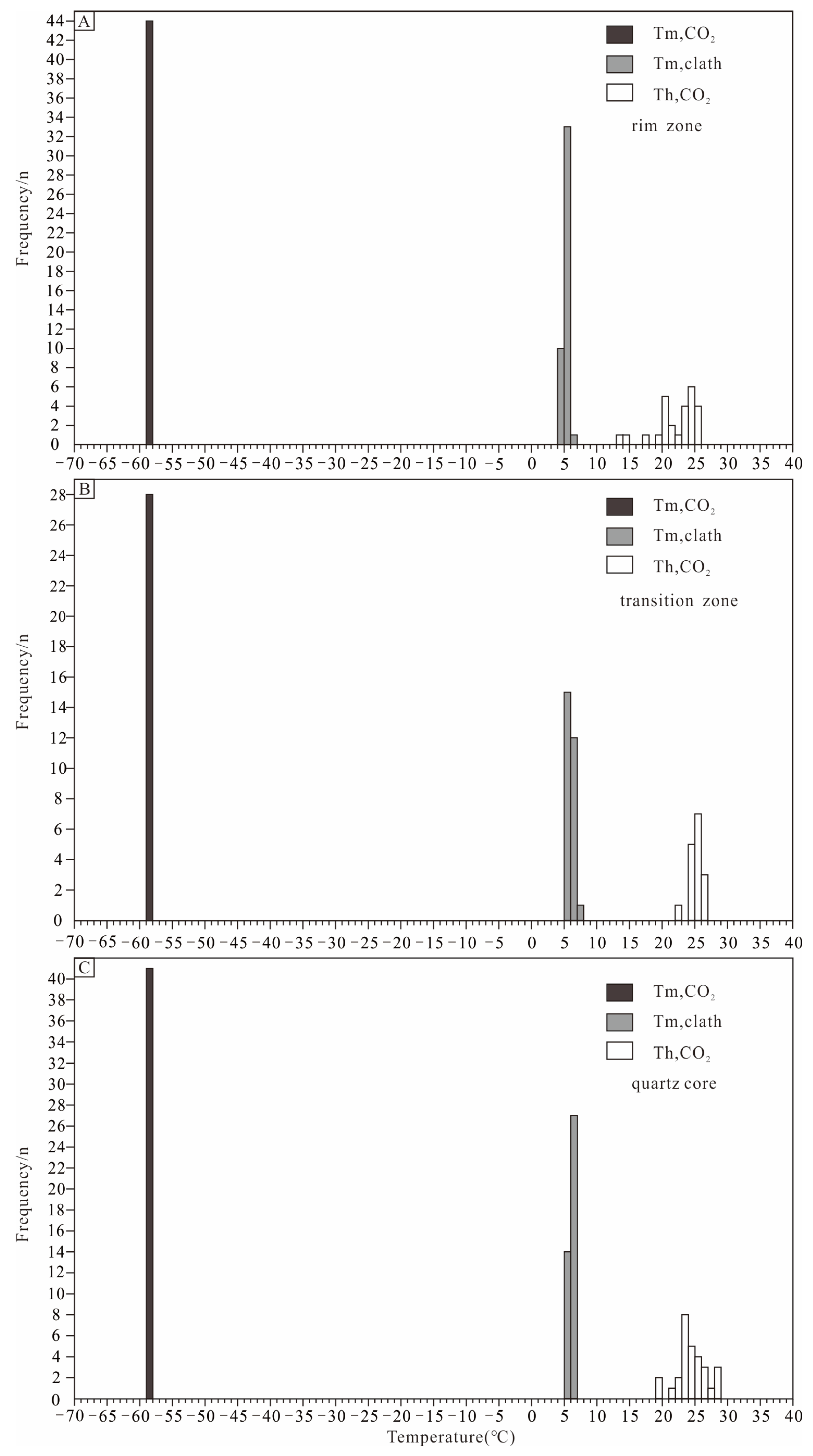
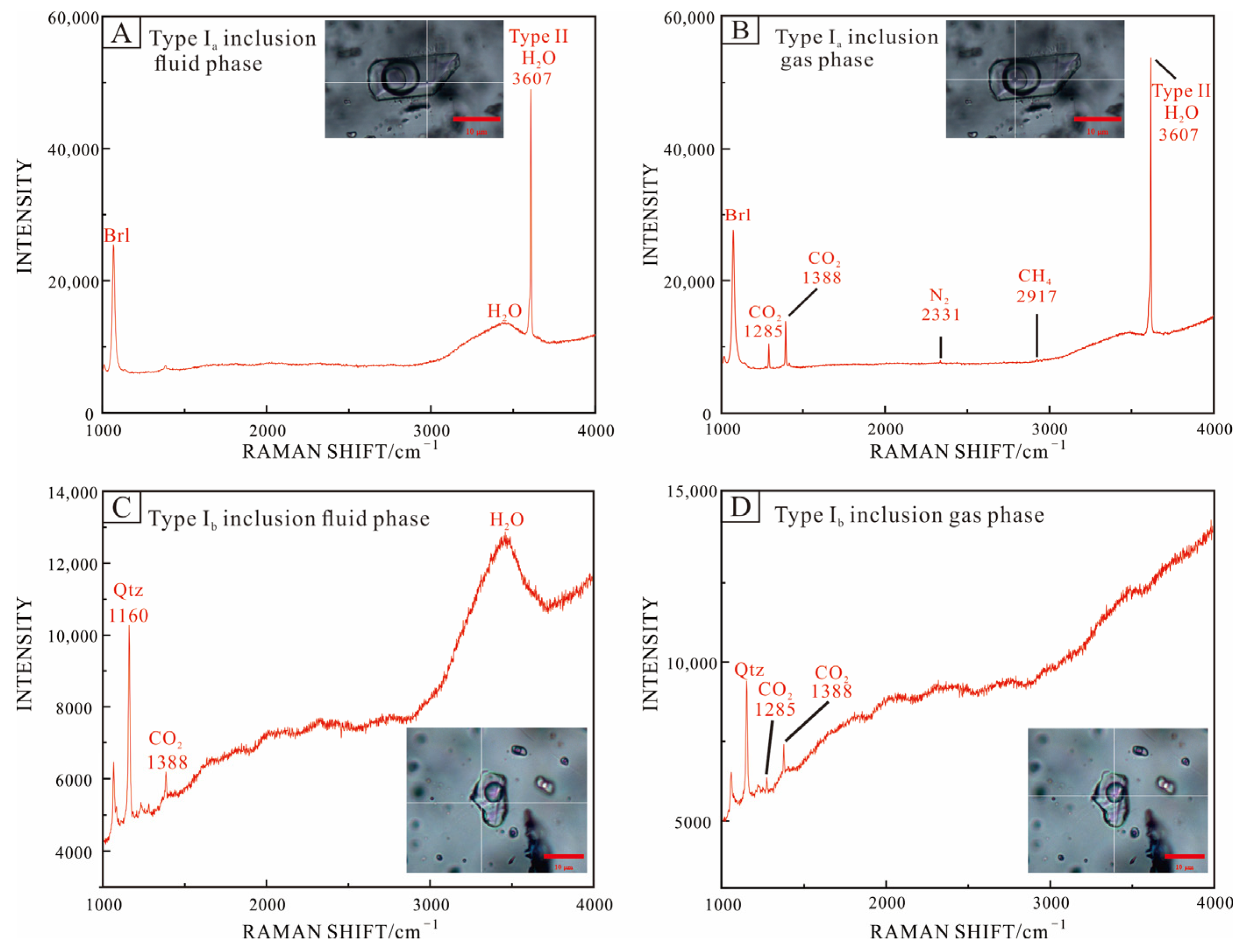

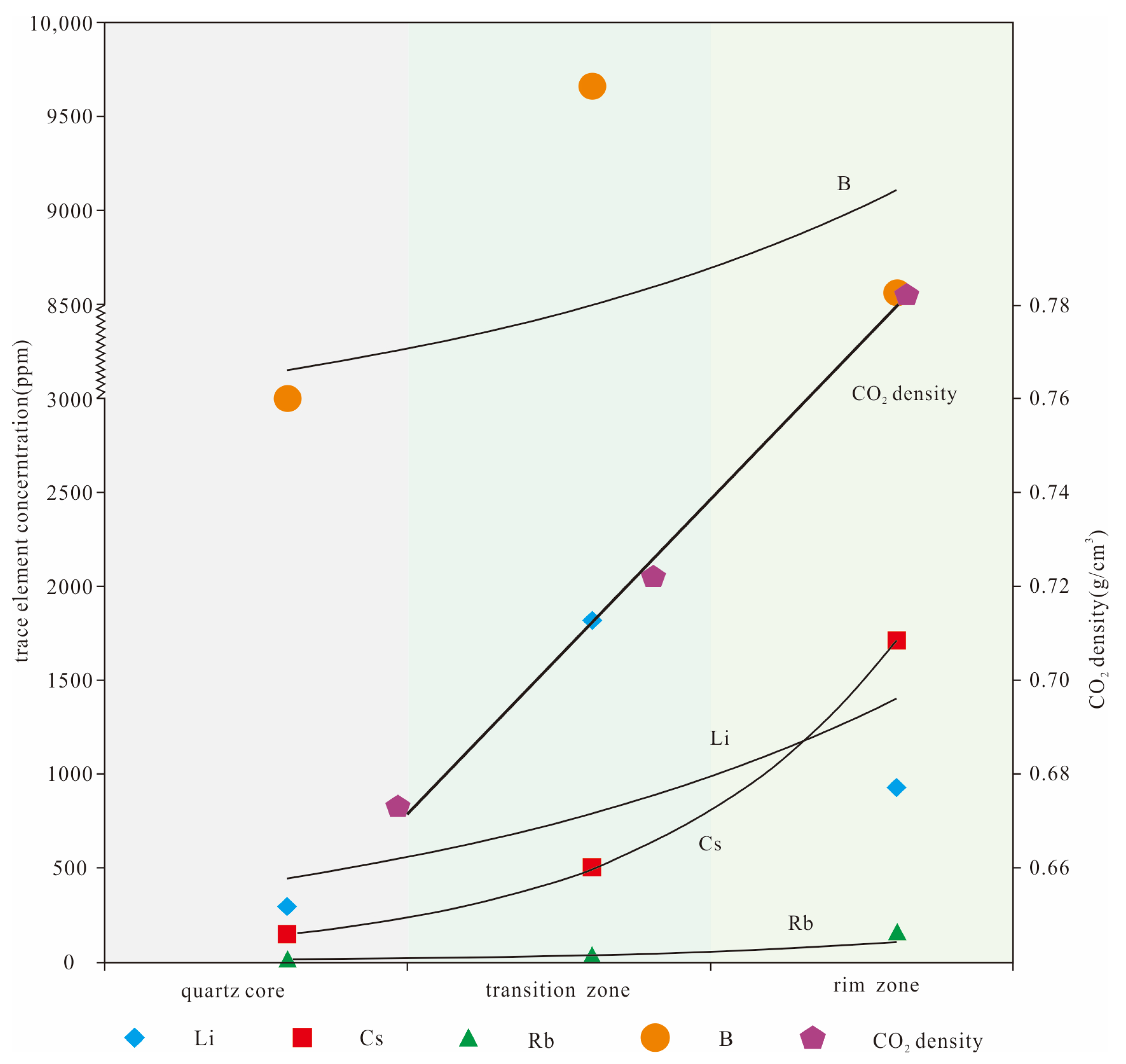
| Stage Division | Inclusion Type | Total Number | Size (μm) | Tm, CO2 (℃) | Tm, ice (℃) | Tm, clath (℃) | Th, CO2 (℃) | Th, tot (℃) | Salinity (wt% NaCleqv) | CO2 Phase Density (g/cm3) |
|---|---|---|---|---|---|---|---|---|---|---|
| rim zone (beryl) | Ia | 26 | 5~30 | −58.1~−58.6 | 4.1~5.7 | 13.5~25.6 | 242.5~293.4 | 8.0~10.3 | 0.71~0.84 | |
| Ib | 18 | 5~22 | −58.2~−58.5 | 4.7~6.1 | 229.7~280.8 | 7.2~9.4 | ||||
| II | 6 | 8~19 | −6.2~−3.9 | 231.3~242.7 | 6.3~9.47 | |||||
| transition zone (rose quartz) | Ia | 16 | 6~23 | −58.2~−58.4 | 5.0~7.0 | 24.1~26.5 | 253.4~287.5 | 5.7~9 | 0.69~0.73 | |
| Ib | 12 | 7~20 | −58.1~−58.4 | 5.2~6.5 | 240.8~299.4 | 6.5~8.6 | ||||
| II | 9 | 8~17 | −6.9~−4.2 | 240.8~283.8 | 6.7~10.4 | |||||
| quartz core (quartz) | Ia | 29 | 7~29 | −58.2~−58.4 | 5.1~6.8 | 19.5~28.7 | 228.7~278.3 | 6.0~7.7 | 0.65~0.78 | |
| Ib | 12 | 8~18 | −58.1~−58.4 | 5.2~6.8 | 225.5~262.5 | 6.0~7.7 | ||||
| II | 7 | 6~15 | −7~−4.4 | 232.2~267.5 | 7.02~10.5 |
| Sample | A32 | A33 | A34 | A35 | A36 | A41 | A43 |
|---|---|---|---|---|---|---|---|
| Li | 737.7 | 614.8 | 527.1 | 2172 | 316.5 | 390.3 | 1659 |
| B | 2889 | 5702 | 976.7 | 1924 | 3525 | 34,407 | 10,648 |
| Na | 35,917 | 33,478 | 39,497 | 33,478 | 33,478 | 35,917 | 33,478 |
| K | 2813 | 3281 | 2932 | 641.2 | 4052 | 8880 | 3737 |
| Zn | 37.16 | 474.4 | 151.3 | - | 314.1 | 891.1 | - |
| As | 684.3 | 1143 | 120.8 | 194.2 | 171.7 | - | 2735 |
| Rb | 98.46 | 118.9 | 116.7 | 54.74 | 88.15 | 265.2 | 322.9 |
| Sr | 1.40 | 11.59 | 32.28 | - | - | - | - |
| Sb | 211.4 | 139.7 | 120.2 | - | 233.4 | 1717 | 855.6 |
| Cs | 1005 | 1646 | 669.6 | 1505 | 1412 | 1420 | 3842 |
| Ta | 1.23 | - | 1.21 | - | - | - | - |
| W | - | - | 178.8 | - | 43.67 | - | 277.4 |
| Rb/Na | 0.002741 | 0.003552 | 0.002955 | 0.001635 | 0.002633 | 0.007384 | 0.009646 |
| Cs/Na | 0.02799 | 0.04917 | 0.01695 | 0.04497 | 0.04216 | 0.03954 | 0.1148 |
| Cs/Rb | 10.21 | 13.84 | 5.737 | 27.50 | 16.01 | 5.355 | 11.90 |
| Sample | A05 | A06 | A06-2 | A07 | A08 | A09 | A11 | A12 |
|---|---|---|---|---|---|---|---|---|
| Li | 1259 | 1827 | 1186 | 3973 | - | 820.0 | 1353 | 4009 |
| Be | - | - | - | - | 217.5 | - | - | |
| B | 11,981 | 13,446 | 12,314 | 2994 | 2326 | 11,767 | 10,988 | 11,130 |
| Na | 27,066 | 30,291 | 30,291 | 22,345 | 25,728 | 27,734 | 28,364 | 22,345 |
| K | - | 679.4 | 1424 | 2701 | 2580 | 241.8 | 734.9 | - |
| Ti | - | - | - | 1496 | 692.6 | 3468 | 334.9 | 4655 |
| As | 2939 | 840.9 | 1593 | 3281 | 1134 | 4468 | 2710 | - |
| Rb | 15.19 | 16.85 | - | 27.74 | 34.32 | 8.06 | 10.30 | - |
| Sb | - | - | - | 137.04 | - | - | 18.76 | - |
| Cs | 551.9 | 646.2 | 602.9 | 931.9 | 461.2 | 202.4 | 234.2 | 332.2 |
| Rb/Na | 0.000561 | 0.000556 | - | 0.001241 | 0.001334 | 0.000291 | 0.000363 | - |
| Cs/Na | 0.02133 | 0.01991 | 0.03368 | - | 0.01793 | 0.007297 | 0.008259 | 0.001487 |
| Cs/Rb | 36.29 | 38.35 | - | 33.60 | 13.44 | 25.11 | 22.74 | - |
| Sample | A18 | A19 | A20 | A21 | A22 | A23 | A24 | A25 |
|---|---|---|---|---|---|---|---|---|
| Li | 866.7 | - | 362.3 | - | 371.5 | 110.7 | 322.6 | 279.1 |
| B | 2813 | 3028 | 1004 | 3153 | 1434 | 5119 | 3161 | 4191 |
| Na | 27,734 | 27,066 | 29,662 | 27,734 | 3096 | 28,364 | 27,066 | 263,967 |
| K | 1136 | 520.7 | - | 698.8 | 959.7 | 1575 | 692.1 | 710.7 |
| As | 518.5 | 845.1 | 963.2 | 1052 | 925.5 | 1133 | 726.3 | 1097 |
| Rb | 8.83 | 8.71 | 15.12 | 5.40 | - | 18.20 | 27.89 | 26.73 |
| Cs | 166.6 | 101.2 | - | 149.2 | - | 224.2 | 233.9 | 245.2 |
| Rb/Na | 0.000318 | 0.000322 | 0.00051 | 0.000195 | 0.000642 | 0.00103 | 0.001013 | |
| Cs/Na | 0.006007 | 0.00374 | 0.005378 | 0.007905 | 0.008641 | 0.009288 | ||
| Cs/Rb | 18.87 | 11.62 | 27.62 | 12.32 | 8.386 | 9.172 |
Disclaimer/Publisher’s Note: The statements, opinions and data contained in all publications are solely those of the individual author(s) and contributor(s) and not of MDPI and/or the editor(s). MDPI and/or the editor(s) disclaim responsibility for any injury to people or property resulting from any ideas, methods, instructions or products referred to in the content. |
© 2023 by the authors. Licensee MDPI, Basel, Switzerland. This article is an open access article distributed under the terms and conditions of the Creative Commons Attribution (CC BY) license (https://creativecommons.org/licenses/by/4.0/).
Share and Cite
Zhou, J.; Zhang, H.; Tang, Y.; Lv, Z.; Guan, S. Characteristics and Geological Significance of CO2-Rich Fluid Inclusions in Dakalasu No. 1 Pegmatite Dyke, Altay. Minerals 2023, 13, 365. https://doi.org/10.3390/min13030365
Zhou J, Zhang H, Tang Y, Lv Z, Guan S. Characteristics and Geological Significance of CO2-Rich Fluid Inclusions in Dakalasu No. 1 Pegmatite Dyke, Altay. Minerals. 2023; 13(3):365. https://doi.org/10.3390/min13030365
Chicago/Turabian StyleZhou, Jiehao, Hui Zhang, Yong Tang, Zhenghang Lv, and Shenjin Guan. 2023. "Characteristics and Geological Significance of CO2-Rich Fluid Inclusions in Dakalasu No. 1 Pegmatite Dyke, Altay" Minerals 13, no. 3: 365. https://doi.org/10.3390/min13030365
APA StyleZhou, J., Zhang, H., Tang, Y., Lv, Z., & Guan, S. (2023). Characteristics and Geological Significance of CO2-Rich Fluid Inclusions in Dakalasu No. 1 Pegmatite Dyke, Altay. Minerals, 13(3), 365. https://doi.org/10.3390/min13030365






